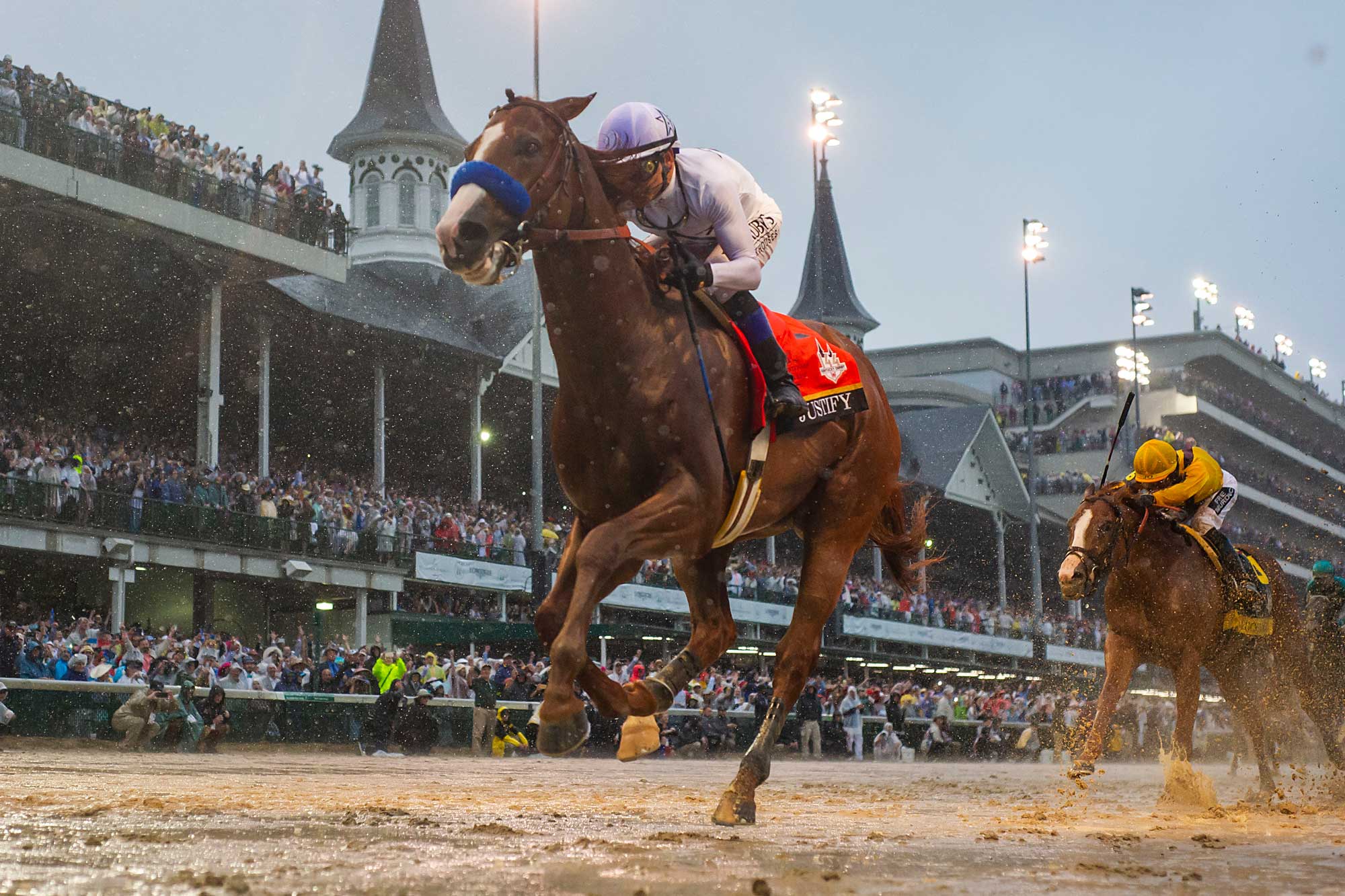Hunter S. Thompson
Churchill Downs
Louisville, Kentucky
By Charlie Cy
In the spring of 1970, thirty-two-year-old writer Hunter S. Thompson returned to his hometown of Louisville to cover the 96th running of the Kentucky Derby for Scanlan’s Monthly.
Less than 72 hours before the race, Thompson was over 1300 miles from Churchill Downs in Aspen, Colorado, busy having, as he later recalled, “one of those long European dinners with lots of wine” with novelist Jim Salter. During the meal Salter prompted Thompson, asking the Kentucky native if he planned on attending the upcoming derby. Intrigued, Thompson immediately phoned his editor Warren Hinckle in San Francisco at 3:30 in the morning, shouting “I have a great idea, we must do the derby. It’s the greatest spectacle the country can produce.”
Straightaway, Hinckle endorsed the pitch and within an hour booked Thompson a ticket, wired expense money and began the hunt for an artist to illustrate the event; Hunter loathed working with photographers, so Hinckle arranged for British illustrator Ralph Steadman, already scheduled to fly to the states, to meet Thompson in Louisville.
What ensued was a frenzied 7200-word, now infamous, first-person account entitled “The Kentucky Derby is Decadent and Depraved.” It was the genesis of gonzo journalism — a unique cocktail of “close to the bone” reporting with subjective, participatory and satirical narration.
The essay, alongside Steadman’s apocalyptic sketches, mostly snubs the horse race, instead fixating on the local inhabitants and cultural milieu surrounding the derby’s pageantry and debauchery:
We hadn’t seen that special kind of face that I felt we would need for a lead drawing. It was a face I’d seen a thousand times at every Derby I’d ever been to. I saw it, in my head, as the mask of the whiskey gentry — a pretentious mix of booze, failed dreams and a terminal identity crisis; the inevitable result of too much inbreeding in a closed and ignorant culture . . . So the face I was trying to find in Churchill Downs that weekend was a symbol, in my own mind, of the whole doomed atavistic culture that makes the Kentucky Derby what it is.
Thompson’s narrative is also set against a volatile national backdrop. He makes numerous references to Nixon’s America. The falling stock market. Bombings in Cambodia. Interminable war in Vietnam. Antiwar protests that led to four students being killed by National Guard troops on the campus of Kent State, which occurred the Monday after the derby. And a racially fraught atmosphere in Louisville and across the country. There are multiple allusions to the Black Panthers, “white crazies,” race riots and a racial caste system.
I first read the piece in the summer of 2015, the same summer I first read Ralph Ellison’s novel Invisible Man. Both struck like lightning. At the time, I was living in the Bronx, blocks above the Harlem River and the northern tip of Manhattan; I was a non-traditional undergraduate student at Columbia University, studying African American studies and political science, hungry to write about America’s racially divided working class.
I’d never read anything quite like Thompson’s story. In many ways it had everything I’d been hunting for in a writer and mentor, especially for a white man born below the Mason-Dixon Line in the Jim Crow era.
Beyond the lean electric prose, comic hyperbole and current of impending doom, Thompson’s narrative provides an unvarnished insider’s view of the social dynamics in Louisville and Churchill Downs.
As both a globetrotting journalist and a native son who’d attended numerous derbies in the past, Thompson proves to be an expert tour guide. He not only captures the nuances of the town and track, he combats any romantic inclination to side with the local tribe and instead actively critiques the customs, class structure and racial strata associated with his hometown’s bankrupt bacchanal — from the Kentucky Colonels “in white linen suits vomiting in the urinals,” to the governor, “a swinish neo-Nazi hack named Louis Nunn,” seated in the “inner sanctum” alongside Barry Goldwater.
Better yet, he ultimately eschews self-righteousness for self-deprecation, turning the finger-pointing on himself in a moment of catharsis the morning after the derby as he discovers the hideous image in the mirror.
There he was, by God — a puffy, drink ravaged, disease-ridden caricature . . . like an awful cartoon version of an old snapshot in some once-proud mother’s family photo album. It was the face we’d been looking for — and it was of course, my own. Horrible. Horrible.
Thompson’s take-down and insider-outsider perspective resonated with me on multiple levels. Though I was raised in Richmond, Virginia, once the capital of the Confederacy, I was born in Kentucky like Thompson. I grew up with a remote connection to the derby, an intimate disdain for American aristocracy and a contradictory subconscious need to fit in, which often manifested itself in grotesque bouts of drunken mayhem with my bourgeois peers.
The piece struck me so much, that fall I sought assistance to produce something similar for my senior thesis. I emailed a former literature professor, Dr. Farah Jasmine Griffin, the director of the Institute for Research in African American Studies, a long letter outlining my circuitous path into her formative seminar “The Novels of Toni Morrison,” to solicit her to be my thesis advisor.
She wrote back, “Yes, I will advise your thesis . . . You are a writer. Therefore, you MUST write.” As a neophyte-wannabe, her words felt like gasoline poured over a dying flame, validating a fragile dream I’d stoked to a point of exhaustion, a dream I feared bordered on delusion. Unfortunately, I never quite captured what I wanted to say for my thesis, and in many ways, I’m still working on that essay today. Nevertheless, after graduating, I would by happenstance move from NYC to Louisville and attend my first derby in 2018 with my dear friend and flat mate Lisa Turner.

Like Thompson’s, our plans were made in haste. It was a rainy, lazy Saturday. But with less than five hours to post in an impromptu fit of spontaneity, we decided to foist ourselves up off the couch in Lisa’s Old Louisville condo less than two miles from the track and attend the 144th Run for the Roses — the wettest derby on record, won by eventual Triple Crown winner Justify.
In three hours’ time, we managed to purchase general admission tickets, hustle downtown to GQ Unlimited to procure proper attire, drive through Ali Baba Liquor Store and Smoke Shop for cigarettes and Old Forester (one bottle would be duct-taped to my calf, the other slugged beforehand), rendezvous with my amphetamine dealer (a mercurial young socialite-hipster I’d met on Tinder who’d first shown me around Louisville), get gussied up, drive to the fairgrounds, shuttle over to the track, enter Churchill’s gates and commandeer two mint juleps to sip and stare at the sea of wildlife getting soaked in the rain with an hour to spare before the paddock judge commanded “riders up.”
The key feat though was improving our station. We had nowhere to go but the infield, “that boiling sea of people across the track from the clubhouse,” as Thompson put it. But Lisa was determined to upgrade. While I was on watch for the slightest sneer by fascist scum directed at her dark skin that stood out like a pink flamingo, she was unfazed and preoccupied, busy eyeing one of the gatekeepers lackadaisically checking tickets to the lower-level bleachers along the homestretch.
The gatekeeper looked checked out like he’d been there all week, as a slew of soused, ivory-faced beasts in ponchos were stampeding in and out of his narrow gate, shouting and slipping over each other on the soaked floors to get to the clogged bathrooms or parimutuel counters to put down bets.
We stood back to study the diabolical flow, while the attendant, anesthetized by the chaos, intermittently checked his phone. I was nervous about our prospects of getting through without being stopped. My veins pulsed with adrenaline and speed. Certain we were doomed, I studied Lisa’s face. Moxie oozed from her eyes. Reassured, I followed her lead as she walked up to the man and glided past him with an arctic poise. We crab-walked down the aisle to open seats, just four rows back from the sloppy track, grinning like hyenas as the rain poured.
Minutes later the crowd, over 150,000 strong, undeterred by the elements, were welcomed to stand and sing “My Old Kentucky Home,” our Commonwealth’s curious state song — a tragic minstrel tune turned derby tradition, bloated with misplaced nostalgia and sentimentality, a song I’d heard sung thoughtlessly since I was a child and grown to despise like the monuments that lined my hometown . . .
Written by Stephen Foster in 1853, eight years before the Civil War, it was inspired by Harriet Beecher Stowe’s Uncle Tom’s Cabin and often performed in the play based on her novel. Written from the perspective of a slave, the lyrics lament being sold down river away from a bucolic Kentucky plantation to a hostile land “where the sugar canes grow.”
Kentucky banned Uncle Tom’s Cabin from being performed in 1906. In 1928, however, the legislature enshrined “My Old Kentucky Home” as the state anthem. In a period rife with Lost Cause fervor and “Old South” reminiscences, the anti-slavery sentiment of Foster’s tune was effaced, and it became instead a paean to the Antebellum South. Over time, it has been further sanitized; in 1986, the Kentucky General Assembly removed a racial slur from the lyrics, providing a path for the syrupy sweet chorus to be reinterpreted once again.
Standing in the rain next to my friend, dressed in a bow tie and suspenders with a bellyful of bourbon, aping the mask of the whiskey gentry, I could not help but sense in my bowels the decadence and depravity of the moment.
Half enthralled by the pomp and circumstance too, I also could not help but feel a hint of shame as a willing participant in this “atavistic” ritual, as the bridled thoroughbreds made their way from the paddock to the starting gate, the crowd wistfully crooning a slave song.
Charlie Cy is a freelance writer and day trader based in Louisville, Kentucky. Over a decade ago, he took a life changing three-month road trip from his home in San Francisco through the Deep South. This polarizing experience would uproot his budding career as a sommelier and lead him to stow his effects in storage, move into his Mini Cooper and live out on the streets of Los Angeles to contemplate next steps. After months of military showering in a McDonald’s bathroom, reading in the North Hollywood Library and sleeping awkwardly underneath the perfumed purple blossoms of jacaranda trees lining the streets at the foothills of the San Gabriel Mountains, he began to forge a new path — and becoming a writer, a dream he’d long deferred, became central to it.
Photograph by Eric Kalet, a professional sports photographer who has shot the major horse races in the United States, including the Kentucky Derby and Breeders’ Cup. His photos have been featured at the National Museum of Racing and Hall of Fame in Saratoga, New York. When Eric is not at the racetrack, he works at Jefferson University Health, a chief health, hospital, and university system in Greater Philadelphia, as a Human Resources Business Partner. Eric has received several special recognitions for diversity, equity and inclusion efforts during his human resources career.


























































